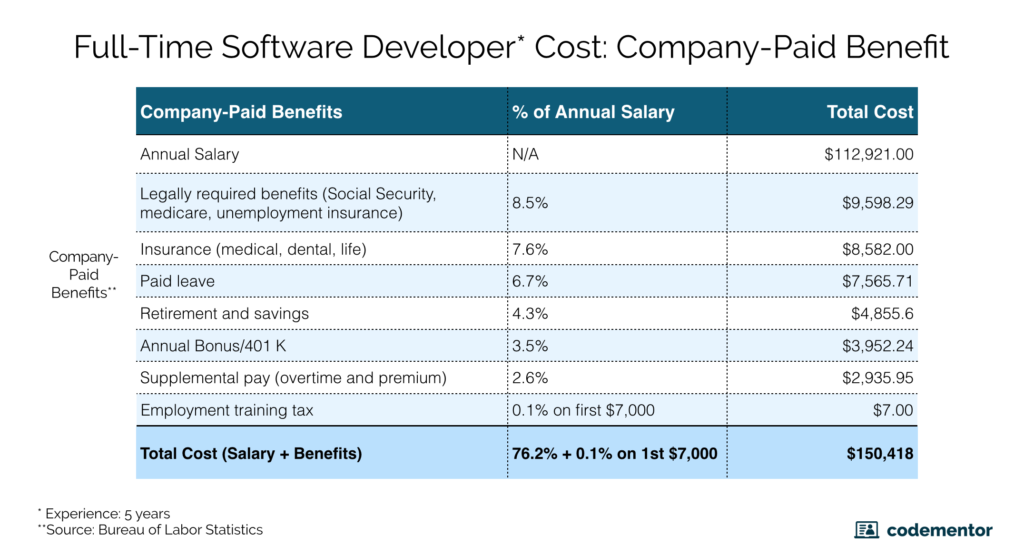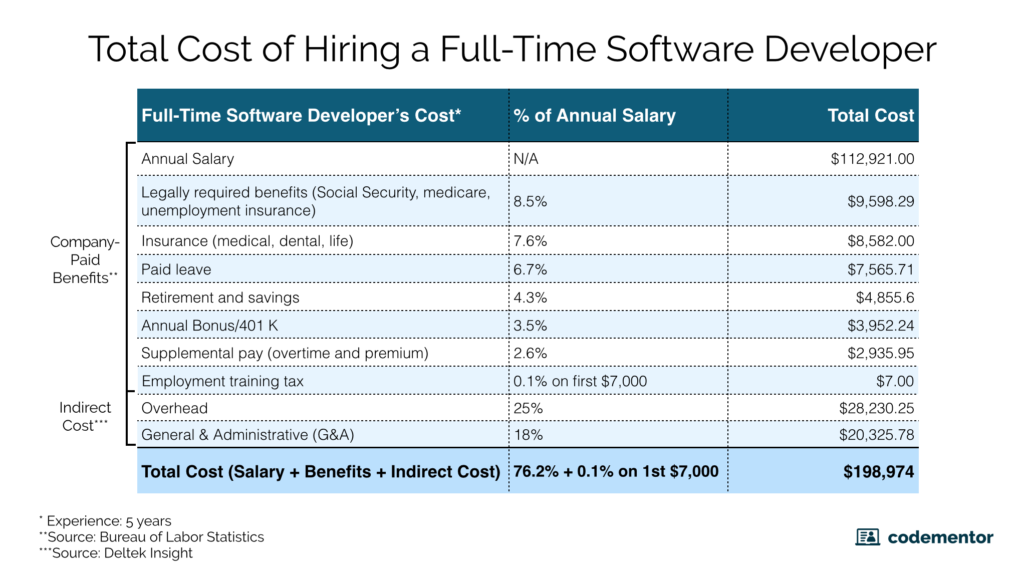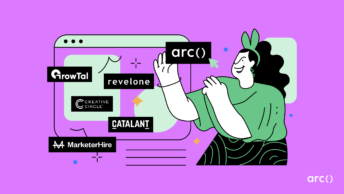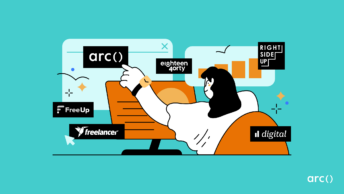As the “gig economy” continues to flourish, hiring managers are presented with alternative ways to hire talents for their businesses. According to Intuit’s forecast, the on-demand economy will reach 43% by 2020. Many companies are already taking advantage of the gig economy.
We understand that hiring software developers is not an easy matter. What is the company vision? What are the priorities on hand? What is the hiring budget range? These are some of the basic questions hiring managers must consider.
Should you hire full-time employees or freelance developers? We aim to provide some helpful insight to answer that question.
Though there are many ways to approach the subject, we will focus purely on the costs of hiring full-time employees and freelance developers.
Looking for top talent fast? See how Arc can help you:
⚡️ Find developers, designers, marketers, and more
⚡️ Freelance or full-time remote + fully vetted
⚡️ Save up to 80% with global hires
Hire top talent with Arc risk-free →
Annual Salary Comparison
Method of Comparison
When it comes to hiring full-time employees, their salaries are usually calculated on an annual basis. Most of the time, companies will not hire freelancers all year round. One of the benefits of hiring freelancers is to hire them whenever you need them — this means most freelance hires will likely be short-term engagements.
Though unlikely, we will calculate the annual salary of both full-time employees and freelance developers for comparison’s sake. We will use this equation to formulate their annual salary:
Freelance hourly rate x average hour (1790 hrs) = Annual Salary
Note: According to the Organization for Economic Co-operation and Development, the average annual hours actually worked per worker in the United States is 1,790 hours in 2015.
Annual Salary for Full-Time Software Developers:
Software developers’ annual salary varies depending on their working experiences. The following data from PayScale applies to software developers with 5 years of experience.

PayScale shows the range of annual salaries, excluding outliers, for software developers with 5 years of experience. We will focus on the median annual salary for software developers: $112,921. Next, let’s look at freelance developers’ annual salaries.
Read More: What a Freelance Developer Contract Should Include (w/ Templates)
Annual Salary for Freelance Developers:
The cost of hiring freelance developers varies significantly from one country to the other. The range of hiring freelancers in North America goes from $50 to $250. The range is significantly lower in Eastern Europe and in India (see below):

Since there is a wide range of hourly rates for freelance developers, we will use real data from Arc for more accurate analyses of the rates for vetted freelance developers. If you were to hire quality freelancers from Arc, you’d find that most freelancers charge somewhere between $60-$100 per hour. Therefore, we will use $60-$100 per hour for our analysis.
Let’s perform a similar calculation to find out the median annual salary of these freelance developers:
Freelance hourly rate x average hour (1790 hrs) = Annual Salary

Annual Salary Comparison:
The annual salary for hiring freelancers at an hourly rate of $60 – $100 will result in $107,400 – $179,000. Is it cheaper to hire freelancers or full-time software developers?
Hiring freelancers can be quite straightforward; however, hiring full-time employees come with a lot of other costs.
Let’s look at some in-house costs that we haven’t included yet.
Read More: 14 Toptal Alternatives to Hire Freelance Software Developers & More
Other Costs of Hiring Full-Time Employees
Company-Paid Benefits
Lots of startups, companies, and businesses are offering special benefits such as unlimited paid leave, unlimited coffee, free gym memberships, and much more to attract top talents. These are all costs that should be factored into hiring full-time developers. First, let’s take a look at some of the most basic company-paid benefits according to the Bureau of Labor Statistics:
- Legally required benefits (Social Security, Medicare, unemployment insurance): 8.5%
- Insurance (medical, dental, life): 7.6%
- Paid Leave: 6.7%
- Retirement and savings: 4.3%
- Annual Bonus: 3.5%
- Supplemental pay (overtime and premium): 2.6%
- Employment training tax: 0.1% on first $7,000
Next, let’s use the median salary for software developers to conduct a deeper analysis:

As we can see, the total cost is now around $150,418. Now, that’s $37,500 more than what we originally thought we’d be paying our software developer! Would you be saving money by hiring freelancers now? The short answer is that it can still go both ways.
There are some other indirect costs that we haven’t considered. Let’s look at some of those.

Indirect Costs
What exactly are indirect costs? They’re overhead costs that contribute to the company’s day-to-day operations. Some examples of indirect costs include cleaning supplies, office equipment, and computers. According to Deltek, a global ERP software provider, indirect costs can be divided into three broad categories: fringe benefits, overhead, and general & administrative (G&A). Since fringe benefits have been covered already, we will only discuss overhead and G&A costs.
Companies spend an average of 25% and 18% of employees’ salaries on overhead and G&A. If we break this down according to a full-time software developer’s salary, we’d be looking at
- $28,230.25 on overhead and
- $20,325.78 on G&A
Now let’s combine these costs with the salary and other benefits for full-time software developers.
$150,418 + $28,230.25 + $20,325.78 ≈ $198,974
Here’s a summarized table of all the costs that are not reflected in a full-time software developers’ salary:

As the table shows, the additional costs, which were not reflected in the software developer’s annual salary, amounted to $86,053 — 76% of the developer’s annual salary.
Now, we can compare the true cost of hiring a full-time employee and a freelance developer annually.
Read More: Hiring Developers Online: Freelance vs Recruitment Agencies vs In-House
True Cost Comparison
Instead of comparing full-time and freelance developers’ annual salaries, it is more accurate for us to compare the total annual cost:

We can see from this comparison, that it is significantly cheaper to hire freelance developers. You could save up to almost 50% by hiring freelancers instead of full-time employees!
Keep in mind, that the cost of hiring a full-time employee mentioned above pertains to engineers with only 5 years of experience. You can easily find freelance software engineers with 10+ years of experience in the $60 – $100 hourly rate range. What’s even better is that you can find freelance developers whose past experiences directly align with your specific industry, which further cuts down the cost by shortening the onboarding time.
Although 50% seems like a lot already, you can save even more by hiring freelance software engineers. Let’s discuss some other factors that make hiring freelancers even more cost-effective.
Other Factors to Consider
In addition to the diversity of freelance developer costs globally, there are other factors that can make hiring freelancers more flexible and cheaper.
Short Term Engagement & Specific Projects
As we mentioned earlier, most people do not hire freelance developers all year round — the annual cost of a freelance developer we just discussed may be an overshoot. Most startups and companies only hire freelance developers when they have specific needs that need to be satisfied. Here’s a common scenario:
Jasmine is a solo non-tech founder who wants to build an MVP for her idea, an Instagram-like mobile app. She knows that her Instagram clone will take around 3-4 months to develop. She is hoping to hire two developers to speed the process up so she can deliver the MVP in 2.5 months. Should Jasmine hire two full-time developers or two freelance developers?
At this point in time, it would make more sense for Jasmine to hire two freelance developers — she has a very specific short-term goal. Since it is just an MVP, Jasmine most likely wouldn’t have a very clear idea of the development timeline after its release.
If she were to hire two full-time developers, she may have nothing for them to do while they’re waiting for market feedback on their MVP. Even though the full-time developers may not be working on any projects, she would still have to pay them!
Let’s say Jasmine hires two freelance developers at the rate of $9,000/month per person. She would spend $45,000 on these freelancers. But, if she were to hire two full-time employees at $100,000/year, she would be spending $200,000. She would be saving a significant amount of money by hiring freelance developers.
Read More: Toptal vs Upwork, Fiverr, Arc: Where to Find Great Freelance Developers?
Different Ways of Paying Your Freelancer
In addition to hiring freelance developers only when you need them, you also have the flexibility of paying freelancers in different ways.
Depending on your needs, you can pay freelancers by the hour, by the day, or by the project. Paying freelancers by the hour and by the project are more common than paying by the day. If you have a rather small task on hand, you may consider setting a fixed rate for the project. On the other hand, if you have a bigger project, freelancers may be more likely to charge by their hourly rate. However, these “rules” are not set in stone.
When it comes to drafting a contract, payment terms will most commonly be classified as fixed cost, hourly, or retainer. To learn more about payment terms, you can read this post on How to Pay a Freelance Developer. For more information on how to file taxes on work your freelance developer has done on your behalf, read this post on Freelance Taxes.
Flexibility in Hiring
Hiring freelancers may also reduce the amount of money spent on keeping employees that are performing at a sub-par level afloat. Oftentimes, companies allow underperforming employees to stay in their companies out of fear of being sued.
On the contrary, companies have more flexibility when hiring freelancers — if the hired freelance software developer is not a good fit, companies have the freedom to search for an instant replacement with less bureaucracy than hiring a full-time employee.
All that is to say, partnering with freelancers is not only a cheaper option, but it also provides you with more flexibility to customize how you would like to work with developers.
Read More: Good Developers Don’t Always Make Good *Freelance* Developers
TL;DR
Whether you’re partnering with freelancers in the long run or in the short run, it is a lot cheaper to hire freelance developers as opposed to full-time employees. As previously demonstrated, you can hire vetted developers at less than 50% of the cost of full-time employees.
Not only is it cheaper to hire freelancers, but it also allows you to have more freedom and flexibility.
Should you hire full-time employees or freelance developers? Again, hiring developers is not an easy matter — there are a plethora of factors to consider. What we have provided is a rather simple cost comparison and some cost-effective options for hiring top-notch developers. In the following posts, we will offer an even more in-depth analysis of the pros and cons of hiring full-time vs. freelance developers.
After all, our mission is to help you succeed!
You can also try Arc, your shortcut to the world’s best remote talent:
⚡️ Access 450,000 top developers, designers, and marketers
⚡️ Vetted and ready to interview
⚡️ Freelance or full-time








